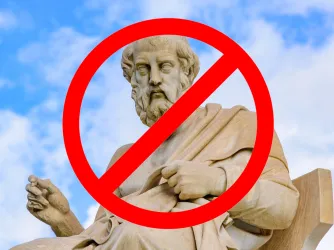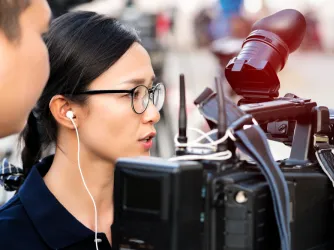Table of Contents
Yet another campus blasphemy dispute in Minnesota: Macalester College covers up Iranian-American’s feminist art exhibition after student complaints

Ken Wolter / Shutterstock.com
On the heels of a national controversy over blasphemy and art at nearby Hamline College, now St. Paul, Minnesota’s Macalester College is mired in its own dispute over artistic imagery and religious offense, complete with a “content warning” and black curtains temporarily censoring artwork.
On Jan. 27, an exhibit by Iranian-American artist Taravat Talepasand opened at the college’s Law Warschaw Gallery, the culmination of conversations taking place between Talepasand and the college since 2019. The exhibit, TARAVAT, comments on a range of issues related to gender and religious and political power.
The works include a neon light display of “Woman, Life, Freedom,” a reference to the protests taking place in Iran since the death of Mahsa Amini at the hands of the country’s morality police as well as other works showing a man beheading two women, and a teddy bear referencing a blasphemy case in Sudan.
After TARAVAT causes “deep pain,” administrators hide it behind curtains
A series of images, titled Blasphemy X and Blasphemy IX, and sculptures depicting niqab and hijab-clad women with exposed body parts or visible lingerie especially caused a stir. Students decried these “overtly sexualized” images in a petition shared after the installation of the exhibit.
“Though we respect the principle of academic freedom, we are also simultaneously aware that freedom, like art, does not simply exist in a vacuum. The decision to display and continue to display this exhibition despite the harm it perpetuates is a deeply problematic issue. It is targeting and harming an already small community that exists on this campus,” students wrote. “The lack of action on the part of the administration is unacceptable, but unfortunately not surprising. The administration’s decisions continue to ignore the deep pain felt by many of their students.”
Ikran Noor, the Macalester student who started the petition, said “a lot of it is really proactive and really supportive of the Iranian women’s movement that’s happening,” but she believed “the ones that are particularly depicting hijabi women and niqabi women, I think those should be put down.”

At a community meeting held to discuss complaints about the art, some Iranian students reportedly shared their support of their exhibition despite their peers’ objections.
Nevertheless, after the meeting to discuss student opposition to the exhibition, the college temporarily closed it, and covered windows with large black curtains to obscure all of the art.
Obstructed glass and “non-consensual” art
In an email sent to the campus this week, the college announced the reopening of the gallery — with some caveats. During the shutdown, Macalester wrote, “we had several conversations with students, faculty, and staff to consider multiple perspectives from Muslim communities on campus, worked with the artist, and supported gallery staff. We also prepared the gallery to prevent unintentional or non-consensual viewing of certain works and added a content warning.”
That’s right: obscured windows to prevent “unintentional,” “non-consensual” glimpses of works of art. In an American campus art gallery.
Citing “the value and importance of artistic expression, including provocative art used in protest and social activism,” Macalester wrote that the “exhibit will remain open,” but the college recognizes the “harm to members of our Muslim community” from the works.

FIRE calls on Hamline University to reinstate art history instructor dismissed for showing medieval depiction of Muhammad
Minnesota’s Hamline University has betrayed its commitment to “embrace” free expression, including potentially “unpopular and unsettling” ideas.
The gallery’s door is now blocked by a large sheet of purple construction paper to obscure the art from passersby, a warning of “upsetting or unacceptable” images, and a sheet of paper encouraging students to sign the petition objecting to the display. Talepasand agreed to the content warning on the door but objected to the black curtains that covered the images, rightfully calling it out as “censorship” and opposed the presence of the petition against the works being posted on the door.
And as the continuing fallout from the Hamline debacle has illustrated, colleges like Macalester should remember that when they grant some student complaints to censor or obstruct artwork, they may unintentionally be choosing sides in political or religious fights much larger than the presence of some images on campus.
Small liberal arts colleges in St. Paul, Minnesota aren’t the only campuses that have sought to tamp down on a controversy by temporarily censoring art, a lamentable tradition FIRE detailed in its report on art censorship, “One Man’s Vulgarity,” and it’s not even the first time one has used black curtains to shield students’ eyes from the offending works. Salem State University employed a similar method in 2016 after students objected to Ku Klux Klan and other historical imagery used in artist Garry D. Harley’s exhibit critical of Donald Trump.
It is to FIRE’s knowledge, however, the first time a college has employed the curious phrase “non-consensual viewing of certain works.” It’s, frankly, a rather sinister way to define controversial imagery: not just as something that could offend or upset, but as something that violates an accidental viewer’s consent. It’s a comically bad lesson to teach students that they should expect the words and images they encounter through the course of their lives to be understood as an exercise of their own consent, and not another’s right to free expression. That it’s employed for a show that in part protests the violation of women’s rights is an added layer of absurdity.
It’s also a lesson that’s sharply contrasted by the Supreme Court decision that inspired FIRE’s report, “One Man’s Vulgarity.” In the case, Cohen v. California, the Court overturned the conviction of a man arrested for wearing a jacket with the words “Fuck the Draft” in a Los Angeles courthouse.
Though the words were deeply upsetting to some during the unrest of the Vietnam War, Justice John Harlan did not argue that Cohen should be expected to cover his jacket nor receive permission from viewers who may have to see it. Instead, he wrote for the Court that those who wished to avoid seeing it should accomplish it “simply by averting their eyes,” rather than by expecting censorship. Macalester is a private university and therefore is not bound by the First Amendment; however, it would do well to absorb this lesson.
Students should be free to choose whether or not to view the works, rather than having their peers choose for them. Those who don’t wish to see the images have another option than censorship: averting their eyes.
Recent Articles
Get the latest free speech news and analysis from FIRE.

Can the Pentagon strip Mark Kelly’s rank over speech?

Texas A&M to philosophy professor: Nix Plato or be reassigned

Morgan State says cut the cameras, stop the presses


